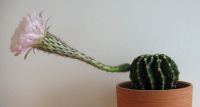Echinopsis oxygona: Difference between revisions
No edit summary |
No edit summary |
||
| Line 1: | Line 1: | ||
{{Inc| | |||
Echinopsis oxygona, Zucc. Sts. at first simple, nearly spherical or rarely clavate, becoming short columnar, reaching 1½ ft. height and 1 ft. diam., gray-green, darker above: ribs 13-15, straight or wavy at the base: radial spines 5-15, horizontally spreading, very unequal, reaching ⅝ in., subulate, obliquely upright; centrals 2-5, somewhat longer, straight, porrect or deflexed, dark horn-colored, with black tips: fls. commonly many together, lateral, reaching 13 in. length, pink to carmine-red, the inner petals lighter than the outer ones. S. Brazil. | |||
}} | |||
{{Taxobox | {{Taxobox | ||
| color = lightgreen | | color = lightgreen | ||
Latest revision as of 13:55, 15 September 2009
| Standard Cyclopedia of Horticulture |
|---|
|
Echinopsis oxygona, Zucc. Sts. at first simple, nearly spherical or rarely clavate, becoming short columnar, reaching 1½ ft. height and 1 ft. diam., gray-green, darker above: ribs 13-15, straight or wavy at the base: radial spines 5-15, horizontally spreading, very unequal, reaching ⅝ in., subulate, obliquely upright; centrals 2-5, somewhat longer, straight, porrect or deflexed, dark horn-colored, with black tips: fls. commonly many together, lateral, reaching 13 in. length, pink to carmine-red, the inner petals lighter than the outer ones. S. Brazil.
|
| Echinopsis oxygona {{{status}}} Fossil range: {{{fossil_range}}}
| ||||||||||||||||||||||||||||||||||||||||||||||||||||||||||||||||||
|---|---|---|---|---|---|---|---|---|---|---|---|---|---|---|---|---|---|---|---|---|---|---|---|---|---|---|---|---|---|---|---|---|---|---|---|---|---|---|---|---|---|---|---|---|---|---|---|---|---|---|---|---|---|---|---|---|---|---|---|---|---|---|---|---|---|---|
 | ||||||||||||||||||||||||||||||||||||||||||||||||||||||||||||||||||
| Plant Info | ||||||||||||||||||||||||||||||||||||||||||||||||||||||||||||||||||
| ||||||||||||||||||||||||||||||||||||||||||||||||||||||||||||||||||
| Scientific classification | ||||||||||||||||||||||||||||||||||||||||||||||||||||||||||||||||||
| ||||||||||||||||||||||||||||||||||||||||||||||||||||||||||||||||||
| [[{{{diversity_link}}}|Diversity]] | ||||||||||||||||||||||||||||||||||||||||||||||||||||||||||||||||||
| {{{diversity}}} | ||||||||||||||||||||||||||||||||||||||||||||||||||||||||||||||||||
| Binomial name | ||||||||||||||||||||||||||||||||||||||||||||||||||||||||||||||||||
| Echinopsis oxygona (Link) Zucc. ex Pfeiff. & Otto | ||||||||||||||||||||||||||||||||||||||||||||||||||||||||||||||||||
| Trinomial name | ||||||||||||||||||||||||||||||||||||||||||||||||||||||||||||||||||
| {{{trinomial}}} | ||||||||||||||||||||||||||||||||||||||||||||||||||||||||||||||||||
| Type Species | ||||||||||||||||||||||||||||||||||||||||||||||||||||||||||||||||||
| {{{type_species}}} | ||||||||||||||||||||||||||||||||||||||||||||||||||||||||||||||||||
| {{{subdivision_ranks}}} | ||||||||||||||||||||||||||||||||||||||||||||||||||||||||||||||||||
| [[Image:{{{range_map}}}|{{{range_map_width}}}|]] | ||||||||||||||||||||||||||||||||||||||||||||||||||||||||||||||||||
| Synonyms | ||||||||||||||||||||||||||||||||||||||||||||||||||||||||||||||||||
| {{{synonyms}}} |
Echinopsis oxygona is native to South Brazil, Uruguay and northern Argentina. Its features include: many robust spines, spherical shape, and a large, nocturnal flower, with sharply pointed lavender petals, and a fine faint scent.